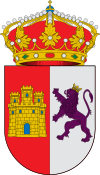Caceres, Spain
| Cáceres | |||
|---|---|---|---|
| Municipality | |||

Collage, Top:Caceres ancient area in Plaza de Santa Maria (Santa Maria Square), Second left:Torre de Bujaco (Bujaco Tower), Second right:Arco de la Estrella (Star Archway), Third left:Caceres Santa Maria Cathedral, Third right:Caceres San Francisco Javier Church, Bottom:Mayor Square and Caceres City Office
|
|||
|
|||
| Location in Spain | |||
| Coordinates: 39°29′N 6°22′W / 39.483°N 6.367°WCoordinates: 39°29′N 6°22′W / 39.483°N 6.367°W | |||
| Country |
|
||
| Autonomous community |
|
||
| Province | Cáceres | ||
| Comarca | Llanos de Cáceres | ||
| Judicial district | Cáceres | ||
| Government | |||
| • Mayor | Elena Nevado del Campo (PP) | ||
| Area | |||
| • Total | 1,750.33 km2 (675.81 sq mi) | ||
| Elevation | 459 m (1,506 ft) | ||
| Population (2014) | |||
| • Total | 95,855 | ||
| • Density | 55/km2 (140/sq mi) | ||
| Demonym(s) | Cacereños | ||
| Time zone | CET (UTC+1) | ||
| • Summer (DST) | CEST (UTC+2) | ||
| Postal code | 10001-10005 | ||
| Website | Official website | ||
| Old Town of Cáceres | |
|---|---|
| Name as inscribed on the World Heritage List | |
 |
|
| Location | Spain |
| Type | Cultural |
| Criteria | iii, iv |
| Reference | 384 |
| UNESCO region | Europe and North America |
| Inscription history | |
| Inscription | 1986 (10th Session) |
Cáceres (Spanish pronunciation: [ˈkaθeɾes]; Extremaduran: Caçris) is the capital of Cáceres province, in the autonomous community of Extremadura, Spain. In 2014 its population was around 96,000. The municipio has a land area of 1,750.33 km2 (675.81 sq mi), the largest geographically in Spain. The walled city has been declared a UNESCO World Heritage Site.
There have been settlements near Cáceres since prehistoric times. Evidence of this can be found in the caves of Maltravieso and El Conejar. The city was founded by the Romans in 25 BC.
The Old Town (Parte Antigua) still has its ancient walls; this part of town is also well known for its multitude of storks' nests. The walls contain a medieval town setting with no outward signs of modernity, which is why many television shows and films have been shot there . The Universidad de Extremadura, and two astronomical observatories are situated in Cáceres. The city is also a seat of the Roman Catholic Diocese of Coria-Cáceres.
Cáceres was declared a World Heritage City by UNESCO in 1986 because of the city's blend of Roman, Moorish, Northern Gothic and Italian Renaissance architecture. Thirty towers from the Islamic period still stand in Cáceres, of which the Torre del Bujaco is the most famous.
...
Wikipedia



